We grow castor oil plants in the open field
In household plots, you can often see a tall, powerful bush with wide patterned leaves. This is a castor oil plant. Planting and caring for the plant does not require special skills, so it is quite easy to grow a kind of palm tree in front of the house. It quickly stretches upward and gives the garden an original rainforest look.
Description of the plant
The birthplace of castor oil plants is African countries. In subtropical climates, it grows like a perennial and often reaches 9-10 m in height. In our country, the plant does not withstand the harsh winter, and therefore it is planted every spring from seeds and looked after as an annual.
The main decoration of the castor oil plant is its bright leaves, consisting of several lobes and somewhat resembling maple leaves. They create the unique atmosphere in the garden. In the middle of summer, the plant produces small stems, on which nondescript flowers bloom. The pollination of castor bean occurs with the help of the wind, so the flowers do not have a strong smell to attract bees, and do not differ in the brightness of the colors. After flowering, balls appear, completely covered with needles. They contain many seeds, which are harvested in sunny weather, dried and stored until spring to be used for planting.
Important!
Don't forget that castor oil plants are very poisonous. Inside its flowers and seeds is ricinin, which is very dangerous to humans. Therefore, the cultivation and care of castor oil plants require compliance with safety rules. Always wash your hands after handling it and protect them with gloves when picking seeds. Keep small children away from the plant and be sure to make sure that the planting material does not fall into their hands.
Valuable castor oil is extracted from castor bean. Experts do not advise doing this on your own by watching a training video on the Internet. It is possible to completely get rid of toxic substances only at a pharmacological enterprise, using special technology. It will not be possible to cleanse the seeds from the poison at home, and the cooked oil, instead of being beneficial, will seriously harm or even lead to tragedy.
Variety selection
In nature, there is one type of plant - castor oil plant. By crossing, scientists bred different varieties that differ from each other in the color of shoots and leaves. Therefore, each grower can choose their favorite color, ranging from bright green to burgundy.
The most popular undersized varieties:
- "Zanzibar" - grows up to 2 m and has red-purple shoots;
- "Gibson" - reaches 1.5 m and is distinguished by the metallic sheen of the leaves;
- "Kazachka" - this variety, bred by domestic breeders, grows no more than 2 m. It stands out favorably against the background of others with a motley red-green color and bright red flowers.
Of the high varieties of castor bean often planted "Northern Palm", which has powerful green shoots and leaves.
How to plant seedlings
The castor oil plant is afraid of even minor frosts, so its cultivation will be more successful if the seedlings are prepared. It should be planted at the end of March.
The seeds of the plant are dense, germinate for a long time without careful preparation and have a low germination rate. Therefore, you first need to do seed scarification. To do this, they need to be gently rubbed with sandpaper from all sides. This helps open up the tough shell and facilitates seed germination. Then, overnight, the planting material is soaked in water or in a solution to stimulate growth. Means "Heteroauxin" or "Epin" will do.
To make care for castor bean seedlings easier, it is advisable to grow them in liter plastic cups. Fill them in half with fertile soil and plant 2 seeds in each, deepening them into the ground by 2 cm.Pour lightly with water, cover with plastic wrap, put in a sunny place and wait for shoots. As soon as the first shoots appear, remove the film, providing the seedlings with complete care, which consists in regular watering and gentle loosening of the soil in cups.
The castor oil plant grows rapidly. When it has several leaves and it reaches a height of 10 cm, it can be transplanted into open ground. But this should be done not earlier than the last night frosts have ended, otherwise the tender seedlings may die. The optimal time is late May or early June.
Transfer to soil
Prepare the bed a week before planting castor bean. Choose a sunny spot for her, protected from wind and draft. Loose fertile soil with constant moisture is ideal. Dig small holes 40 cm deep and 50 cm apart. Fill them a third with manure, sprinkle with earth and cover with oilcloth. In 7 days, manure will warm the soil. This will help the seedlings take root faster and make growing easier.
- Fill well the glasses with castor bean sprouts with water. This will form a wet ball around the root system.
- Then carefully remove the plants along with a lump of earth and place them in the prepared holes, from which you first remove the oilcloth.
- Cover with earth, lightly tamp and pour.
Planting castor oil plants in open ground is possible without preparing seedlings. It germinates well from seeds right in the garden and grows well, if night frosts do not interfere. At the end of May, dig shallow holes in the flower bed, wet them with water and put a few prepared seeds in each. Cover with soil and water the garden bed. If the air temperature is high enough, the first shoots will not be long in coming. When they grow up, leave one shoot in the holes, and carefully cut the rest at the root with a sharp knife.
Growing a plant from seeds in the open field has one significant drawback. If the summer is cool, and early autumn follows it, the castor oil plant will not have time to fully ripen the seeds. And next year they will have to be bought for planting in the store.
How to care for an exotic garden decoration
The plant is unpretentious, so caring for the castor oil plant is simple. Pay special attention to watering. Small shoots planted in the soil literally in a month reach a height of 1-1.5 meters and continue to actively develop. They constantly need moisture. Therefore, the main care is regular watering. Spend it every 5-6 days, pouring 10 liters of water under each bush. When flowers appear, watering should be increased, especially if the summer is too hot.
So that weeds do not interfere with castor bean seedlings and drown out its growth, they must be systematically weeded. On the 2nd day, after each watering, be sure to loosen the soil. Such maintenance will prevent the formation of a dense crust on the soil and enrich the earth with oxygen.
Since the castor oil plant grows tall and branched, it is difficult for the root system to keep it upright. Many summer residents drive pegs around the plant, pull a dense thread and hold a young bush with such a support.
Do I need to feed the castor oil plant?
Plant care is not complete without regular feeding. For the rapid growth and development of castor bean shoots, nitrogen is needed. Be sure to apply nitrogen fertilizer a week before flowering. Organic poultry manure can be applied, which is a good source of nitrogen.
Advice
Do not use pure fresh droppings. It contains a high concentration of uric acid, which can damage the roots.
- To prepare top dressing, pour water into a large iron bucket and dilute in it chicken droppings in a ratio of 10: 1.
- Leave the container in the fresh air for 10 days, during which do not forget to stir occasionally.
- During this time, the droppings will ferment. Add a half-liter jar of fertilizer under each castor plant. Such care will greatly improve her growth.
When the brush of the flower is practically formed, you need to fertilize the earth. phosphorus-potassium fertilizing... A novelty called AVA... In addition to phosphorus and potassium, it contains 9 substances that improve plant growth. The drug must be diluted and introduced into the soil strictly according to the instructions.
You can use wood ash instead of purchased fertilizer. This top dressing fully enriches the soil with phosphorus and potassium. To prepare the solution, you will need to stir 150 g of ash in 10 liters of water and carefully pour half a liter of liquid under each plant.
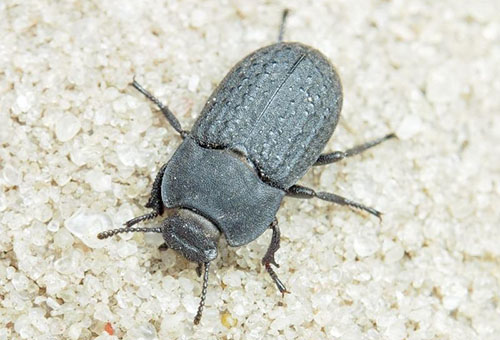
Diseases and pests
The castor oil plant is very hardy and practically does not get sick. If you notice that its leaves have begun to turn yellow and look inconspicuous, most likely they lack moisture. Intensify watering, after which you thoroughly loosen the soil.
Rarely, a bush is affected by gray or black rot, powdery mildew and other fungal diseases. When this happens, timely removal of infected shoots, leaves and treatment with Bordeaux liquid will help.
Sometimes pests begin to erode the castor oil plant. The main ones are:
- wireworm;
- sandy linger;
- caterpillars of meadow moth and winter moth;
- meadow bugs.
To prevent the appearance of a wireworm in the garden, before planting castor bean, pour a little weak manganese solution into each hole.
Collect the caterpillars on the castor oil plant with your hands and then treat with a solution of wormwood.
- Collect half a bucket of fresh herb. Cut it with a knife and top up the bucket with water.
- Insist 3-4 days, then strain and spray the leaves and soil under the castor oil plant.
Spices will help scare off pests from the flower bed. Plant close to castor oil plants mint or dill... Their strong smell will not allow harmful insects to settle in the garden.
Minimal outdoor care for castor oil plants will help turn your backyard into a chic exotic place. Many summer residents are happy to plant it along the fence. The tall plant reliably hides the yard from prying eyes and also absorbs dust and smog from the road.
Castor bean cultivation is also used in landscape design. It looks great in a flower bed along with other flowers.
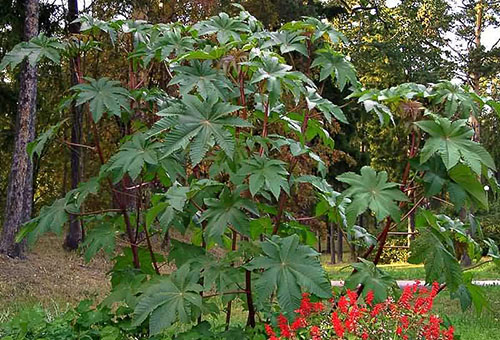
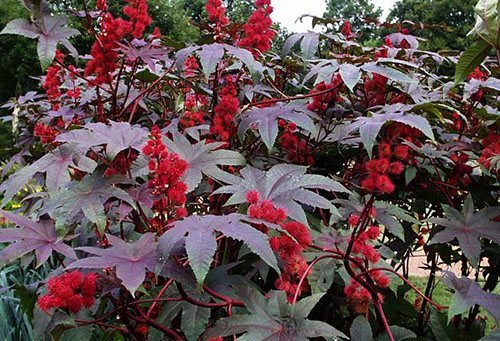
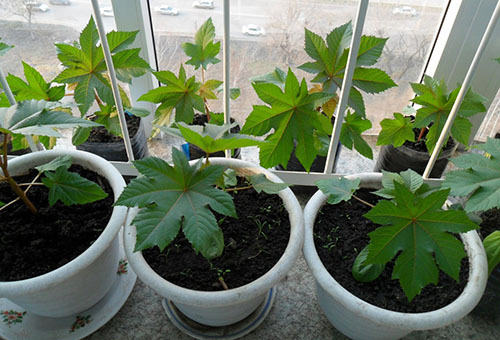
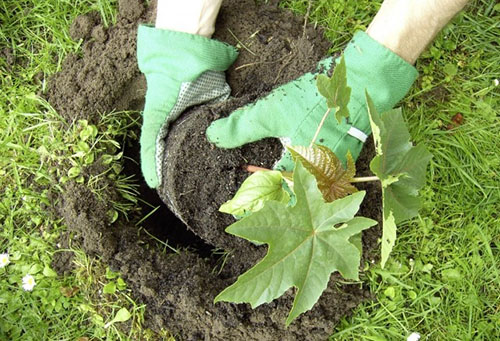
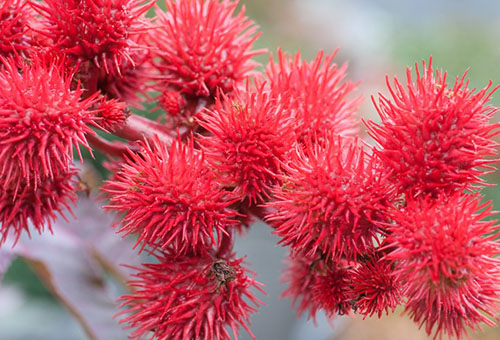
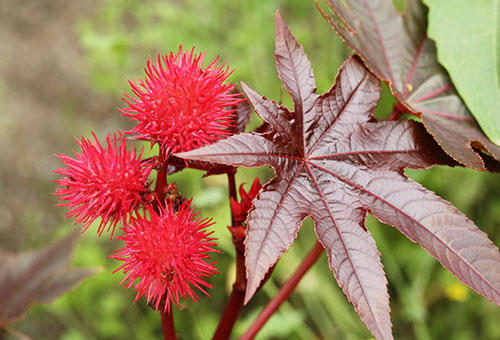
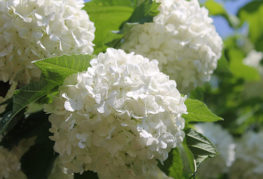
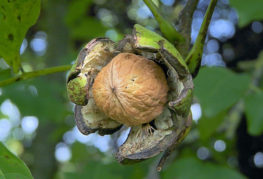
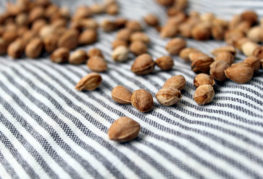

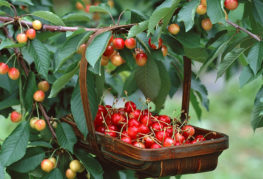
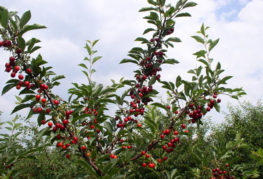
and will be published shortly.